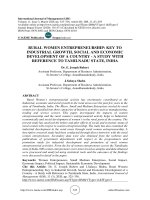Economic growth and economic development 674
Bạn đang xem bản rút gọn của tài liệu. Xem và tải ngay bản đầy đủ của tài liệu tại đây (117.68 KB, 1 trang )
Introduction to Modern Economic Growth
• Weak Equilibrium (Relative) Bias: an increase in the relative supply of a
factor always induces technological change that is biased in favor of this
factor.
• Strong Equilibrium (Relative) Bias: if the elasticity of substitution between
factors is sufficiently large, an increase in the relative supply of a factor
induces sufficiently strong technological change biased towards itself that
the endogenous-technology relative demand curve of the economy becomes
upward-sloping.
At first, both of these results appear surprising. However, we will see that they
are quite intuitive once the logic of directed technological change is understood.
Moreover, they have a range of important implications. In particular, subsection
15.3.3 below shows how the weak and the strong relative bias results provide us with
potential answers to the questions posed at the beginning of this section.
15.2. Basics and Definitions
15.2.1. Definitions. Before studying directed technological change, it is useful
to clarify the difference between factor-augmenting and factor-biased technological
changes, which are sometimes confused in the literature. For this purpose and for
much of the analysis in this chapter, we assume that the production side of the
economy can be represented by an aggregate production function,
Y (t) = F (L (t) , H (t) , A (t)) ,
where L (t) is labor, and H (t) denotes another factor of production, which could
be skilled labor, capital, land or some intermediate goods, and A (t) represents
technology. Without loss of generality imagine that ∂F/∂A > 0, so a greater level
of A corresponds to “better technology”. Recalled that technological change is Laugmenting if
L ∂F (L, H, A)
∂F (L, H, A)
≡
.
∂A
A
∂L
This is clearly equivalent to the production function taking the more special form,
F (AL, H). In the case where L corresponds to labor and H to capital, this is
also equivalent to Harrod-neutral technological change. Conversely, H-augmenting
technological change is defined similarly, and corresponds to the production function
660









